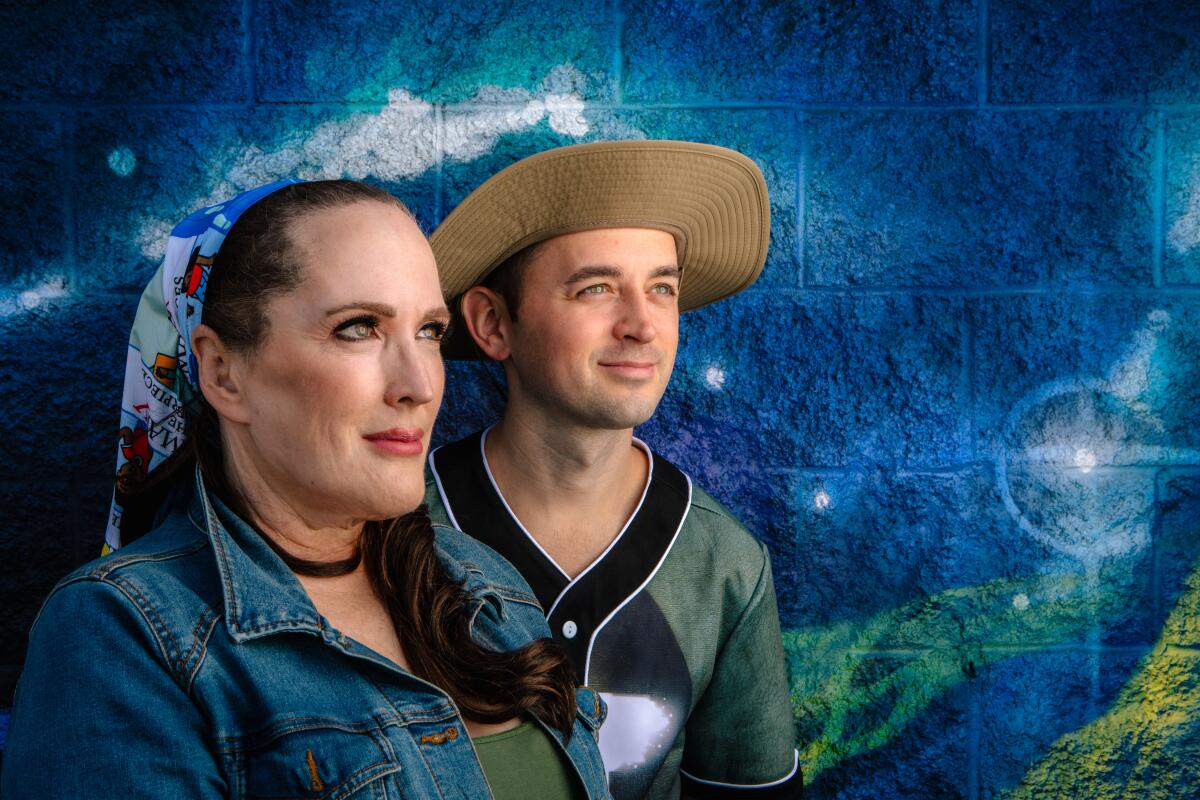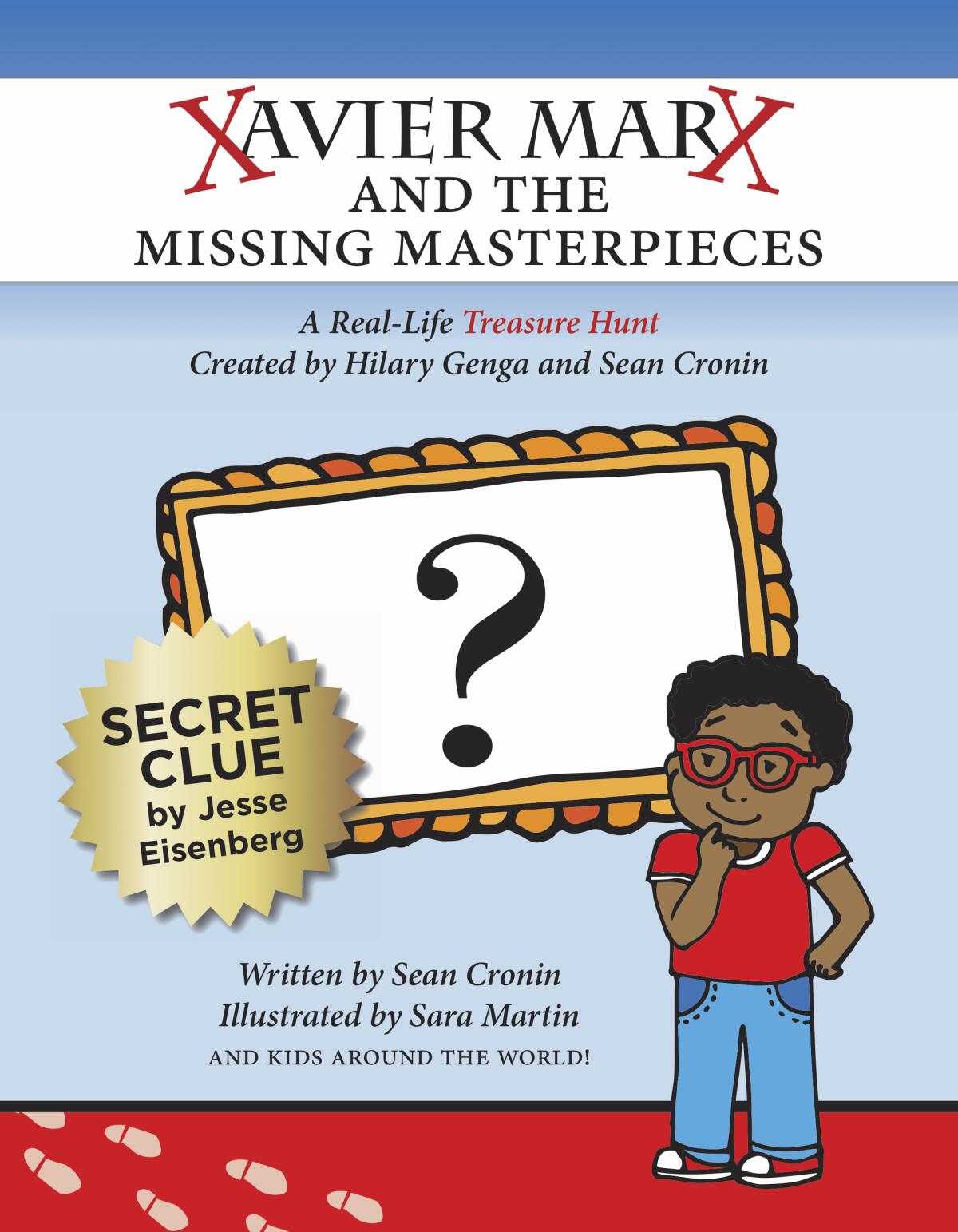Inside the $10,000 treasure hunt embedded in a children’s art book

- Share via
X marks the spot in a new children’s book titled “Xavier Marx and the Missing Masterpieces.” Created by Hilary Genga and Sean Cronin, this rhyming story about an elementary school class field trip to a museum contains all the clues young readers need to solve a $10,000 treasure hunt.
With a secret clue written by actor Jesse Eisenberg, and additional bonus clues supplied via the book’s Instagram page by celebrities including Jason Alexander, Wil Wheaton, Ethan Cutkosky, Melissa Joan Hart, Clancy Brown, Daymond John and Queen Sandra Diaz-Twine, the adventure will eventually take one lucky winner — or family of winners — to a physical location in the continental U.S. There intrepid treasure hunters can find the hidden token, which can then be redeemed for the prize money.
All proceeds from the book benefit the International Child Art Foundation (ICAF), which nurtures creativity and empathy in young people through art, and also supplied a variety of pictures by child artists that are used to fun effect (and possibly for clues) in the book itself.
“The whole book is up for grabs as far as clues are concerned,” says Genga. “If you solve every clue in the book, you can walk right to the exact spot and get the treasure. If you don’t solve everything, but get in the general area, then it’s more like an Easter egg hunt.”

The book idea came to Genga and Cronin during the early days of the pandemic, when many activities were off-limits and families were looking for safe outdoor options to enjoy together. Genga runs a swimwear company out of Tarzana and Cronin is a filmmaker living in Long Beach. The friends met online years ago as active users of Eisenberg’s game-playing site, oneupme.com. They eventually created their own game for the site.
Genga’s love of games extended to treasure hunts. She had followed the story of the Fenn treasure, which was buried in the Rocky Mountains in 2010 by an art dealer and author named Forrest Fenn. Estimated to be worth $2 million, it was found by a lucky winner in June 2020.
“There’s actually a treasure-hunting community, if you can believe that,” says Genga, adding that she and Cronin entered its ranks when they participated in a few hunts before creating the book, which Cronin wrote and artist Sara Martin illustrated.
Cronin and Genga cracked the code for the Great U.S. Treasure Hunt last year to discover where a token worth $10,000 was hidden. They were trying to find their way to the site in Tennessee when an announcement came that another hunter had just reached it.
“We got to experience the super-high of solving something, and then the super-low of being like, ‘Oh, shoot, we thought we had $10,000,’” Cronin says and laughs.
The close call led the pair to discuss what they liked and disliked about the various hunts they knew of and had been involved in. That’s when they started thinking about what their ideal treasure hunt would be like. They eventually hit on the idea of a children’s book that would engage the whole family and benefit a good cause.
“Xavier Marx and the Missing Masterpieces” is the story of a little boy, who, by virtue of his name, is always near the end of the alphabet and therefore often the last to be called on.
“I’m a bit of a nerd. And routinely outcast,” he narrates in the book. “But I know that I’m smart, and I know that I’m cool! Even if I’m not the most popular in school.”
During a class trip to an art museum, however, Xavier emerges as the hero when the museum’s masterpieces go missing and he solves the case.
The book concludes with a mischievous twist, reminding young readers that art is in the eye of the beholder — and that the art they create truly matters.
The moral of the story is part of what attracted ICAF co-founder, Katty Guerami, to the project. One of ICAF’s primary events is the Arts Olympiad, an event modeled after the Olympics that takes place every four years. Classrooms around the world participate, with kids producing art for local exhibitions. Winners from those exhibitions take part in the World Children’s Festival on the National Mall in Washington, D.C.
The artwork created by children for “Xavier Marx” was made by recent Arts Olympians, says Guerami, adding that kids were thrilled to have their work in an actual children’s book.
Guerami says she’d like to see major institutions like New York’s Museum of Modern Art feature wings — or even a room — devoted to the work of children, a theme that also comes up in “Xavier Marx.”
She paraphrases the Picasso quote, “It took me four years to paint like Raphael, but a lifetime to paint like a child,” adding that there is a documented phenomenon called “the fourth-grade slump,” which happens to children between the ages of 8 and 12. That’s when kids begin conforming and start to lose their innate creativity as they attempt to satisfy societal ideas of appropriate creative expression.
“So ICAF comes in almost like an intervention,” she says. “We have programs that serve to say, ‘Hey, you know what? Your creativity is great, you have to stick to it. You can go ahead and think outside the box.’”
Genga and Cronin were immediately attracted by this philosophy, and worked to weave it into the book along with the clues to lead readers to the treasure hunt token.
This was no easy trick, say Genga and Cronin. The pair won’t share their secrets, but say they believe that thousands of people are currently searching for the treasure. This includes the hardcore treasure-hunting community who buy all treasure-hunting books as soon as they are released, as well as families all over the country. Some have written to the book’s creators to share where they have been searching — or to posit their solutions.
One mother, Genga says, wrote to say that her 8-year-old daughter became convinced the treasure was inside the wall of her dentist’s office, behind a Van Gogh print. As a rule, Genga and Cronin don’t respond to inaccurate guesses, because they don’t want to give anything away, but in this case, Genga says she had to write back.
“I said, ‘Please tell your little girl that’s a great guess, but the treasure is definitely not inside her dentist’s wall,’” Genga says and laughs.
To all the searchers out there, Cronin advises that they first read the book from front to back cover without looking for any clues. Then he says to dig back in and study each page.
“Think about different options of any possible thing that maybe looks out of place,” he says. “Ask yourself, ‘Well, why would the author do this? Why did the author make this choice? Why did the illustrator make this choice?’ And you can start developing a theory. At the end of the day, it has to lead to a location.”
Hardened treasure hunters beware: Genga and Cronin believe this case has the best chances of being cracked by the imaginative mind of a child.
More to Read
The biggest entertainment stories
Get our big stories about Hollywood, film, television, music, arts, culture and more right in your inbox as soon as they publish.
You may occasionally receive promotional content from the Los Angeles Times.










